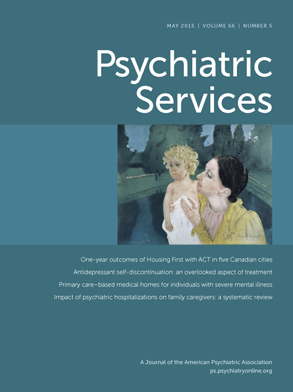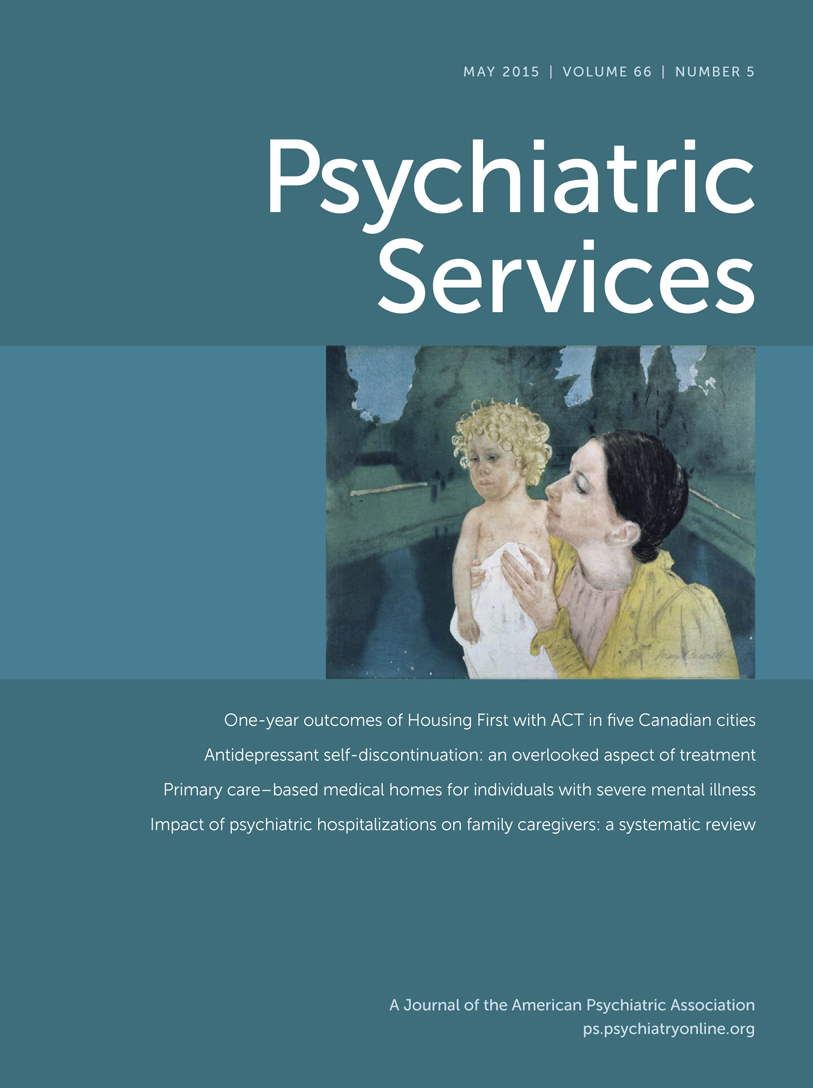Patients treated in inpatient psychiatric hospitals are at high risk of readmission (
1). Rates of readmission vary depending on the population studied (
2,
3). Among Medicare and Medicaid beneficiaries with mental illness, 15%−20% of inpatients are readmitted within 30 days of discharge (
2,
3). Several patient-related factors are associated with readmission risk, including poor medication adherence (
1); substance use disorders (
1); a diagnosis of schizophrenia, bipolar disorder, or depression (
4); and comorbid medical disorders (
5). Homelessness or residence in an institutional setting are social factors associated with psychiatric readmission (
2), and previous hospitalizations (
6), length of hospital stay (
7,
8), and lack of adequate postdischarge care for psychiatric and substance use disorders are system-related factors (
9).
Studies of system-related interventions aimed at reducing readmissions have had mixed results. Having an outpatient visit within seven days of discharge was not associated with lower readmission rates among Veterans Health Administration patients with depression (
10). However, increased outpatient monitoring, measured as the number of outpatient visits after psychiatric hospitalization, was associated with reduced hospitalization among veterans with depression and a comorbid substance use disorder (
11). Continuing care for substance use disorders after discharge was associated with a lower risk of psychiatric rehospitalization in another cohort of veterans (
12). Use of medication management coordinators was associated with greater adherence to outpatient visits and reduced use of hospital crisis or emergency services by patients in a community mental health system (
13).
In this study, we examined factors associated with 30-day readmission rates in a community-based sample of patients admitted to psychiatric hospitals in San Diego County. We hypothesized that receipt of outpatient services after discharge, including individual or group therapy, case management, and medication management, would be associated with decreased risk of readmission.
Methods
We used data from the San Diego County Behavioral Health Services electronic health record system to identify 4,663 adult patients who were admitted to one of 17 psychiatric hospitals in San Diego County between July 1, 2010, and June 30, 2011, and who were discharged before September 1, 2011. For each patient, we obtained information about demographic characteristics, psychiatric diagnosis, hospital admissions, discharge dates, and clinical services utilization after discharge. We included in our assessment all records of outpatient services that a patient received up to 30 days from discharge or until the next readmission if that occurred within 30 days of discharge. Study procedures were approved by the University of California, San Diego, Human Research Protections Program.
We defined the end date of the index hospitalization as the date of discharge. If a patient was readmitted on the day of discharge to the same hospital or to another hospital, the patient was considered to be an inpatient transfer. Patients who were readmitted within 30 days of discharge from the index hospitalization were considered to have experienced a readmission, the primary outcome for this analysis.
We examined three categories of outpatient service use after discharge: individual or group therapy, case management, and medication management. For each day after discharge, we recorded the first outpatient service encounter for that day (
11). We excluded outpatient visits that occurred on the same day as readmission because these visits may indicate an urgent visit leading to rehospitalization.
For each patient, we obtained information on age (18–25, 26–35, 36–44, 45–51, and ≥52 years), sex, race-ethnicity (white, African American, Hispanic or Latino, Native American, Asian, and other), living situation (independent, board and care, institutional, criminal justice system, homeless, and other), and primary clinical diagnosis (schizophrenia, schizoaffective disorder, bipolar disorder, major depressive disorder, other psychotic disorder, adjustment disorder, generalized anxiety disorder, substance use disorder, and other or unknown). To estimate the number of people with any substance use disorder irrespective of other psychiatric diagnoses, we included a separate indicator variable on substance use disorder. We extracted from medical records the length of stay of the index hospitalization and whether the patient had a previous hospitalization within 30 days of the index hospitalization.
We examined the association between demographic variables and use of health care services and 30-day readmission status with chi square tests. In these bivariate analysis, we calculated the visit rate as the number of visits divided by the days to readmission or days until censoring (at 30 days) in order to standardize the visit rate among those who were readmitted soon after the index hospitalization compared with those who were not readmitted. We then examined the adjusted association between receipt of outpatient services and the number of days to readmission by using a discrete-time survival model with a complementary log-log (cloglog) function in a time-varying covariates framework (
14). This framework accounts for the unequal periods of observation resulting from readmission or censoring and also accounts for variations in the use of outpatient services after discharge. Once a patient had an outpatient visit, we assumed that the “effect” of that outpatient intervention would remain constant until readmission or censoring. To achieve this, we created an indicator variable for each visit type, which was 0 for each day before the visit and 1 for each day thereafter. We adjusted for variables that have been shown to be associated with readmission (
11–
13)—age, sex, race-ethnicity, living situation, psychiatric diagnoses, substance use, length of hospital stay, and previous hospitalization. To investigate confounding by treatment indication, we conducted a sensitivity analysis by excluding data for patients who were readmitted within seven days of the index hospitalization. All analyses were conducted with Stata, version 11.
Results
The mean±SD age of the 4,663 adult patients was 38.9±13.3 years, about half were female (N=2,167, 47%), and half were white (N=2,357, 51%). A total of 631 patients (14%) were African American, 1,004 (22%) were Hispanic or Latino, 28 (<1%) were Native American, 225 (5%) were Asian, and 418 (9%) were in the racial-ethnic group “other.” Of the 4,663 adult patients who were admitted between July 1, 2010, and June 30, 2011, and discharged by September 1, 2011, 16% had a readmission within 30 days of discharge from the index hospitalization. Among patients who were readmitted within 30 days of discharge, the average time to readmission was 17.3±8.2 days (median of 18 days and interquartile range of ten to 24 days).
A bivariate analysis indicated that persons who were homeless (N=186, 22%), lived in a board-and-care facility (N=94, 22%), and were institutionalized (N=51, 31%) were more likely to be readmitted than those living independently (N=361, 14%) (p<.001). Persons with schizophrenia or a schizoaffective disorder (N=368, 23%), bipolar disorder (N=128, 20%), and major depressive disorder (N=145, 15%) were more likely to be readmitted than those with all other psychiatric diagnoses (p<.001). Persons with a diagnosis of a substance use disorder were more likely than those without a substance use disorder to be readmitted (N=539, 21%, compared with N=223, 11%, p<.001).
The average length of the index hospitalization was 6.8±11.7 days, and more than half the patients did not have an outpatient visit after discharge (N=2,524, 54%). Bivariate analysis indicated that patients who were readmitted had a slightly longer index hospital stay (7.6±10.9 versus 6.7±11.7 days, p<.03) and a higher rate of outpatient visits (.1 ±.2 versus .08 ±.1 visits, p<.001) than those who were not readmitted. Among those who had an outpatient visit after discharge, 1,545 (33%) received therapy, 780 (17%) received case management, and 1,105 (24%) received medication management. [A table summarizing these results is included in an online data supplement to this report.]
An adjusted proportional hazards model examined factors associated with readmission (
Table 1). Compared with patients who were independently housed, those living in a board-and-care facility (hazard ratio [HR]=1.39), those who were institutionalized (HR=2.76), and those who were homeless (HR=1.67) had a greater likelihood of being readmitted. Those with a substance use disorder (HR=1.52) and those who had a previous hospitalization within 30 days of the index hospitalization (HR=3.02) were more likely to be readmitted than their counterparts. Patients with a diagnosis of schizophrenia or schizoaffective disorder were significantly more likely to be readmitted than those with other diagnoses, with the exception of bipolar disorder. Of the three types of outpatient psychiatric services examined, receipt of outpatient therapy after discharge was associated with a significantly greater likelihood of readmission (HR=1.36); receipt of case management or medication management after discharge was not significantly associated with readmission within 30 days. Results of the sensitivity analyses were qualitatively similar to those of the primary model, except that receipt of case management was also associated with a higher likelihood of being readmitted within 30 days (data not shown).
Discussion and Conclusions
In this community-based sample of patients discharged from an inpatient psychiatric facility, 16% were readmitted within 30 days of discharge. The readmission rate was comparable to rates observed in nationally representative samples of Medicare or Medicaid beneficiaries with mental disorders (
2,
3). As in previous studies (
2,
4,
9,
15), persons who were institutionalized or homeless and who had a diagnosis of schizophrenia or schizoaffective disorder were more likely than those without these characteristics to be readmitted. Contrary to our hypothesis, we found that receipt of outpatient therapy after discharge was associated with a higher risk of readmission, as was case management in our sensitivity analysis in adjusted models. Receipt of medication management was not associated with readmission.
The observed increased risk of readmission among persons who received outpatient therapy after discharge is likely due to reverse causality. Persons with greater psychiatric morbidity may be more likely to receive outpatient therapy after discharge, and when they present to their appointments they may be more likely to be in crisis and be readmitted. To investigate this possibility, in a sensitivity analysis, we excluded individuals who were readmitted within seven days of discharge, assuming that they would have greater psychiatric morbidity. However, results were consistent with the primary model, suggesting that such reverse causality may hold generally—not only among patients with the highest morbidity.
We did not find an association between receipt of medication management after discharge and readmission within 30 days. It is possible that individuals receiving outpatient therapy may be more closely observed for functional deterioration after discharge and, therefore, more likely to be readmitted than those who receive medication management. Persons who receive any outpatient services after discharge may also be at particularly high risk of readmission because of psychiatric comorbidities, and these underlying risk factors may outweigh the benefits rendered by the outpatient psychiatric services.
Our study had several limitations. We were unable to control directly for psychiatric comorbidity. We were able to track psychiatric readmissions in San Diego County but not admissions in other areas or to private or nonpsychiatric hospitals. We considered only county-funded services for aftercare and were unable to include services received through private insurance or other community programs. It is possible that residual confounders, not accounted for in this study, may explain the inconsistent effects of outpatient psychiatric services and hospital readmission.
Despite these limitations, our study focused on a community-based sample that was diverse in gender and race-ethnicity and that had a broad range of psychiatric diagnoses for which there is little information on risk factors for psychiatric readmission. We found that receipt of some types of outpatient services may be associated with increased risk of readmission among recently discharged psychiatric patients. Future studies are needed to understand the reasons for this association, including whether patients with greater psychiatric morbidity are more likely to be assigned to outpatient services in order to provide more opportunity to detect functional deterioration, leading to earlier readmission.
Acknowledgments
Dr. Vijayaraghavan was supported by grant 22XT-0020 from the California Tobacco-Related Disease Research Program. The authors thank San Diego County Behavioral Health Services for access to its health information systems.

